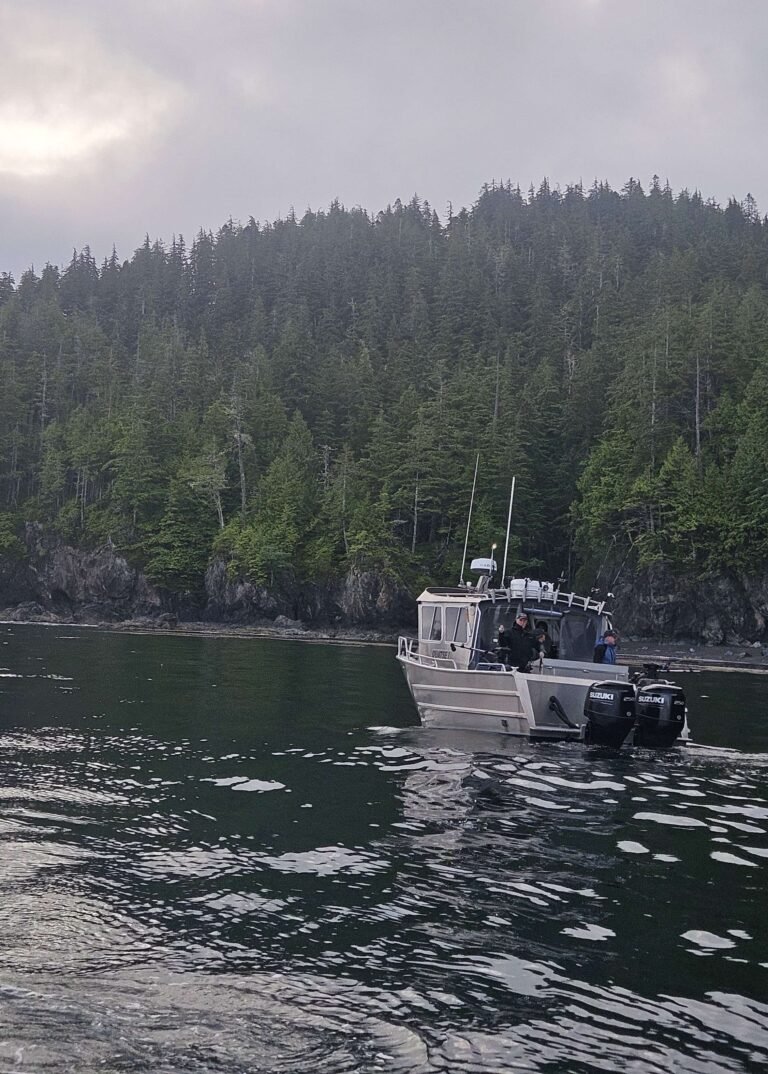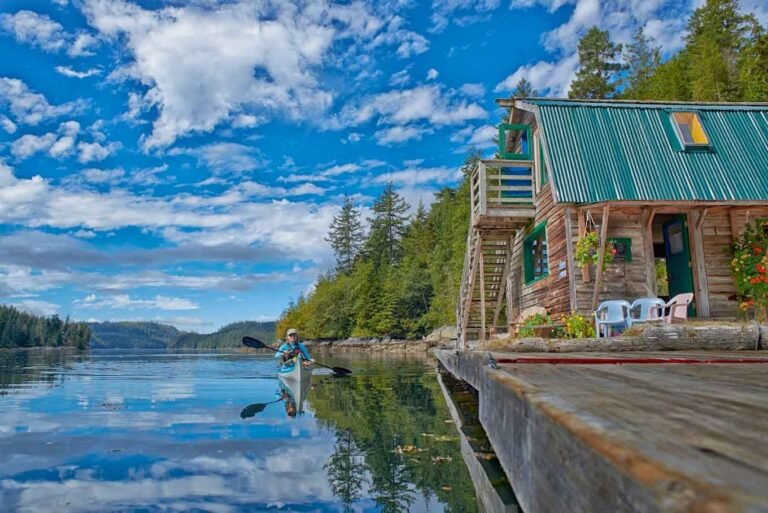Wildlife Viewing Tour Operators: Northern BC and Haida Gwaii
Wildlife Viewing in Haida Gwaii (Queen Charlotte Islands)
Haida Gwaii, formerly the Queen Charlotte Islands, is rich in wildlife in the sky, the sea, and on the ground. Many of the animals are native, but some – blacktail deer, elk, beavers, raccoons, and even wild cows in Naikoon Provincial Park – are introduced. Among the native species, expect to see black bears and river otters, birds such as bald eagles, Steller’s jays, and peregrine falcons, and all kinds of ocean creatures, from grey and killer whales to jellyfish and starfish.
One of the best places to see the latter is in Burnaby Narrows on the east side of Moresby Island, accessible only by boat from Moresby camp. Also known as Dolomite Narrows, the waterway connects Juan Perez Sound with Skincuttle Inlet. The narrows are about half a mile (1 km) long, about 160 feet (50 m) wide, and quite shallow, especially at low tide. The bottom is coloured with a cornucopia of sea life: starfish, sea urchins, moon snails, clams, needlefish, sea cucumbers, sea blubbers, red crab . . . the list goes on and on. Because of the high nutrient content in the water, the aquatic life is almost impossibly large and vibrant. From a kayak or other small boat the viewing is good; with a mask and snorkel, it’s even better. At low tide it is possible to walk along the shore, but as this can’t be done without treading on delicate life forms, it is discouraged.
It can be reached only by boat or plane, but nothing is more idyllic than relaxing in a hot spring on Hotspring Island and watching a pod of orcas swim past. Killer whales, or orcas, are often sighted in the Juan Perez Sound region. Best time for whale watching is late spring and early summer.
Eagles are a common sight, as are dozens of other birds scattered about the islands. A good place to go to is the Delkatla Wildlife Sanctuary near Masset, at the head of the Delkatla inlet. Sandhill cranes stop here in spring and fall on their migratory routes, and tundra swans stay for the winter. Dozens of other birds – coots, snipe, and various species of duck and geese among them – can be found here at different times of the year. Another common resting spot for migrating birds is the Rose Spit Ecological Reserve in Naikoon Provincial Park.
Fully one third of the province’s sea lion population calls Haida Gwaii home. A large colony hauls up on Joseph Rocks, off the west coast of Graham Island, miles away from the nearest point of road access. This is a trip best made by boat or kayak. Only experienced paddlers should attempt travelling along the exposed west coast of Haida Gwaii, though. A second, water-access-only site for viewing sea lions is located at the southernmost tip of Haida Gwaii, on a string of islands called the Kerouards.
All manner of seabirds, including the horned puffin, can also be seen. Visitors in this area can never be sure what manner of creature will show up. A pod of orcas, a grey or a humpbacked whale, or perhaps a gang of Dall’s porpoises, numbering up to 300 strong, may escort you as you sail or paddle along in the southern section of Gwaii Haanas National Park.
Wildlife Viewing in Northern BC
The Northeast
It is almost impossible not to observe wildlife as you travel through the Northeast, the so-called ‘Serengeti of North America.’ The area’s spectacular wildlife fauna consists of eight species of wild ungulates, namely Stone sheep, mountain goats, bison, moose, elk, caribou, and white-tailed and mule deer; plus at least seven species of large and medium-size carnivores including wolves, coyotes, foxes, grizzly bears, black bears, lynx, and wolverines. Deer, moose, bears, and elk frequent clearings alongside roads, foraging for food. In some areas, salt licks have been placed near the road to attract ungulates. Be careful when driving these roads, especially at night; if you were to hit a moose, chances are good that your vehicle would come out of the encounter in worse shape than the moose. Honest.
Eskers Provincial Park near Prince George has wheelchair-accessible facilities to Pine Marsh and Circle Lake. Pine Marsh in particular is a great place for bird-watching, but moose and beavers also inhabit the park. To reach the park, travel about 25 miles (40 km) west of Hwy 97 on Chief Lake Road.
Pink Mountain is a designated viewing area for wildlife in this region, and places have been cleared to provide browsing territory for ungulates. One of the rarer browsing species is the plains bison, but almost all the ungulates are represented, as well as several carnivorous species. Pink Mountain’s real claim to fame is the high population of rare Arctic butterflies.
The defining feature of Stone Mountain Provincial Park is the mountains: great humps of raw stone rising from the valleys below, where only the barest plant life – lichen, grasses, moss – survive. You wouldn’t expect to find much in the way of wildlife here, and in truth, you won’t find much on the bare slopes. But the valleys are a different matter. Mountain caribou and Stone sheep winter in some of the lower valleys, and mountain goats, moose, and grizzly and black bears also frequent the valleys. A number of bird species live in the park, none more magnificent than the golden eagle. Watch for Stone sheep beside the Alaska Highway 97 between here and Liard River and a favourite stop at Liard Hot Springs.
Fraser Plateau
The Vanderhoof Bird Sanctuary in Riverside Park in Vanderhoof is a migratory bird rest area on the Nechako River in Vanderhoof. Farther north, Tyhee Lake Provincial Park, near Smithers, has trails and a wildlife viewing platform in a marshy area on the popular lake – popular, that is, with loons, grebes, beavers, and, oh yes, swimmers and sunbathers in summer.
The Bulkley and Skeena River Valleys
If you can’t find the mythical monster in Seeley Lake, there’s still a chance to see a legend in this region – a white black bear. Native legend in this area tells of a magical white bear that will help, rescue, and protect humans. One of the rarest bears in the world, the Kermode Bear, is found only in the Terrace area and on some islands in the Douglas Channel, including Princess Royal Island. The Kermode bear (Ursus americanus “kermodei”) is a beautiful white bear that is only found in the rain forests of the north coast of British Columbia. The Kermode bear is not an albino, nor is it a polar bear, but rather a pale colour form of the black bear. It ranges from light chestnut blond to steel blue-grey, appearing almost white. These bears, once hunted nearly to extinction, are now under provincial protection. Harming the Kermode is strictly prohibited, but as the bears haven’t signed a reciprocal agreement, remember to use the same caution around these animals as you would around any other bears.
The Gitnadoiks River Provincial Park is home to mountain goats, moose, trumpeter swans, and all five species of salmon. This classic, U-shaped valley contains the entire drainage of the Gitnadoiks River, a major tributary of the Skeena, upriver from Prince Rupert. The ocean currents backing up into the Gitnadoiks, also known as the Gitnadoix River, are so intertidal that seals pursue spawning salmon as far as 60 miles (100 km) upstream to Alastair Lake. Alastair Lake is one of British Columbia’s three known nesting sites for trumpeter swans, the largest waterfowl in the world. Getting to Alastair takes some effort. Unlike its southern sister, the Stein Valley, the Gitnadoiks is not served by a little river ferry to help adventurers cross the skookum Skeena River. Charter aircraft or boat travel via the Skeena River from Prince Rupert is the way to go.
In recognition of the large bear population in this region, the first and only grizzly bear sanctuary in Canada was established 28 miles (45 km) northeast of Prince Rupert. As the Khutzeymateen Grizzly Bear Sanctuary is a protected area, human activity is not encouraged. However, controlled viewing is permitted, although access is only by boat and floatplane. All visitors must register at the ranger station near the Khutzeymateen River estuary. Viewpoints look over the estuary and shoreline, and offer a chance to glimpse the black bears, mountain goats, martens, wolverines, wolves, porcupines, river otters, beavers, and harbour seals that share the sanctuary with the grizzlies.
In March and April, eulachon run in the mouth of the Skeena River. Basalt Creek, in particular, offers good viewing. Turn off Highway 16 about 12 miles (20 km) east of Prince Rupert. This is a great opportunity to also watch the seals, sea lions, eagles, and gulls in the hundreds, which gather to feed on the small, silvery fish.
Eulachon contain so much oil that they are easily ignited once dried. Try cooking one over a campfire on a thin, sharpened stick the same way that you’d cook a hotdog: they are so tasty that you can eat the whole fish, bones and all.
The Stewart-Cassiar Highway (Hwy 37)
There’s a fish ladder at the south end of Meziadin Lake in Meziadin Lake Provincial Park, where the Nass River flows out. Chinook spawn here in late summer, and it’s truly an impressive sight. Fish of up to 30 lbs (13.5 kg) leap into the air as they navigate the ladder. Across Stewart-Cassiar Hwy 37 from Meziadin Lake is the Hanna Creek Salmon Viewing Area. Best viewing time is late summer-early fall.
The four contingent parks around the Stikine River – Tatlatui, Spatsizi Plateau, Stikine River Provincial Park, and Mount Edziza – are home to hundreds of animal species. Lands within Spatsizi Plateau Wilderness Provincial Park and Tatlatui Provincial Park support a large population of wildlife. The Spatsizi Plateau is one of the most important habitats for woodland caribou in British Columbia, while both parks support a variety of wildlife, including moose, grizzly and black bears, wolves, beavers, hoary marmots, and more than 140 species of birds, including gyrfalcons.
At last count, the Grand Canyon of the Stikine, located in the Stikine River Provincial Park, is home to more than 360 mountain goats, which use the sheer canyon walls as effective protection from all natural predators. Mount Edziza Provincial Park also supports a large population of mountain goats, as well as Stone sheep, moose, Osbourn caribou, grizzly and black bears, and wolves.
Nearly 250 miles (400 km) to the northwest is the Tatshenshini-Alsek Provincial Park. The Tat supports more than 53 species of mammals, including wolverines, blue (or glacier) bear (thought to be a variation of the black bear and found nowhere else Canada), and grizzlies. About 200 of the known 400 Dall’s sheep in the province have their range year-round in this area. The park provides an important travel route for waterfowl, with at least 40 bird species known to use the region. These include trumpeter swans, peregrine falcons, great grey owls, and bald eagles.






